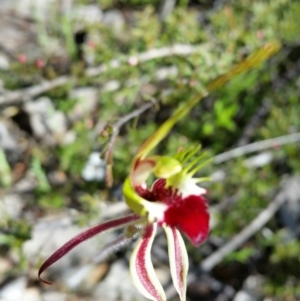Green-comb Spider Orchid at Karabar, NSW
Identification history
| Caladenia atrovespa | 20 Oct 2016 | TonyWood | ||
| Caladenia atrovespa | 20 Oct 2016 | TonyWood | ||
| Caladenia tentaculata | 20 Oct 2016 | roachie |
Identify this sighting
Please Login or Register to identify this sighting.
Significant sighting
6 comments
TonyWood
wrote:
21 Oct 2016
I have confirmed this as C. atrovespa because this is the currently accepted name for the local Green-comb Spider Orchid, although recognising that it is very closely related to C. tentaculata. For a lot of the Spider orchids the only way of separating them is by the pollinator!
MattM
wrote:
21 Oct 2016
And is it possible that natural selection could lead the same species to attract different pollinators due in different areas?
TonyWood
wrote:
21 Oct 2016
Matt, that's a question that should be put to someone more knowledeable. You could ask Tobias.
TonyWood
wrote:
21 Oct 2016
I could have added, at what stage does natural selection result in a new species, but as I said I'm not an expert.
roachie
wrote:
21 Oct 2016
Ah Tony. If I had time I would sit and watch for pollinators. Thank you for your ids and your comments. I'm learning a lot. 😊
TobiasHayashi
wrote:
24 Oct 2016
This may well be Caladenia atrovespa - I think ON AVERAGE they have longer petals and sepals but there is much overlap in most traits with Caladenia phaeoclavia. They are definitely different species, they emit different chemical scents and thereby attract different wasp pollinators.
Matt - natural selection can definitely lead to different populations evolving different so-called semiochemicals and thereby being pollinated by different pollinators. This process can even happen within orchid populations.
As to when things are considered separate species, that is an old and tricky question. Usually species are considered distinct when there is no gene flow between them i.e. there is generally no hybridisation. Obviously there are exceptions to this, but the sexually deceptive spider orchids have extremely strong pre-pollinating barriers (i.e. pollen from C. atrovespa never ends up on C. phaeoclavia plants, because they use two very distinct pollinators).
As far as I know so far, there is no way to definitively tell C. atrovespa from C. phaeoclavia, apart from to see which pollinator they attract - not very helpful I know!
Matt - natural selection can definitely lead to different populations evolving different so-called semiochemicals and thereby being pollinated by different pollinators. This process can even happen within orchid populations.
As to when things are considered separate species, that is an old and tricky question. Usually species are considered distinct when there is no gene flow between them i.e. there is generally no hybridisation. Obviously there are exceptions to this, but the sexually deceptive spider orchids have extremely strong pre-pollinating barriers (i.e. pollen from C. atrovespa never ends up on C. phaeoclavia plants, because they use two very distinct pollinators).
As far as I know so far, there is no way to definitively tell C. atrovespa from C. phaeoclavia, apart from to see which pollinator they attract - not very helpful I know!
Location information
Sighting information
- 1 - 3 Abundance
- 19 Oct 2016 02:28 PM Recorded on
- roachie Recorded by
Species information
- Caladenia atrovespa Scientific name
- Green-comb Spider Orchid Common name
- Sensitive
- Rare or uncommon native
- Non-Invasive
- 364 images trained Machine learning
-
In flower
- External link More information
-
Synonyms
Arachnorchis atrovespa
Record quality
- Images or audio
- More than one media file
- Confirmed by an expert moderator
- Nearby sighting(s) of same species
- GPS evidence of location
- Description
- Additional attributes





